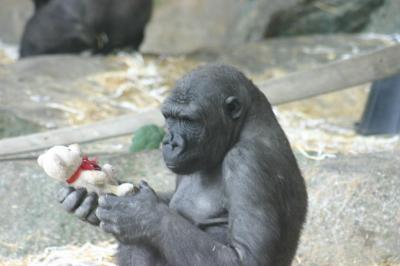The ability to form a general concept that connects what we know about the members of a category allows humans to respond appropriately when they encounter a novel member of that category.
At an early age, children form categories to, for example, differentiate animals from inanimate objects and to differentiate dogs from cats. New research shows that other apes may form similar categories to represent different types of animals.
There are at least two ways to visually identify an animal as being similar to any other: the animals may be within a species and therefore closely resemble each other (so called ‘perceptual’ differences) or the animals may be considered to meet the criteria for a broader mental concept (for example, “reptiles do not have fur, they have short legs or have no legs, and lay eggs – these all seem like reptiles”). Concept formation in human children has been subjected to extensive experimental study, with much focus on the interplay between concept acquisition and language acquisition. It has been proposed that these broader concepts depend upon formal scientific training and/or the ability to form verbal labels for such concepts. If non-human animals represent such concepts, this finding would be evidence against such a view. It is surprising then that the existence of natural categories, such as classification of animals, has not been extensively studied in language–less non-human apes. Studies of concepts in animals have instead paid close attention to the perceptual features that are used by the animals to extract information about category membership but have not typically allowed animals to demonstrate that they can also form concepts at different levels of breadth simultaneously.
In this study, a young female gorilla and four orangutans of various ages were shown images of animals and asked to match them to an image from the same species or family (i.e. one with a perceptual similarity). In an alternate experiment, they were presented with images of animals belonging to different taxonomic classes (insects, reptiles, fish, birds, and mammals) and were asked to match these images to sample images of other members of that class.
In the case of images from within a taxonomic class (for example different reptiles) each image naturally shared fewer perceptual features, presumably making it more difficult for the apes to match the images correctly using only perceptual strategies. If the apes were using a purely perceptual strategy then they should find it harder to match images from the same classes compared to matching images from within the same species or family. However, the orangutans were actually able to match images from the same classes at a higher level of accuracy than they were able to match images from within the same species or family, indicating that they may have formed a concept for the class of animal that extended beyond perceptual similarity. The gorilla was also able to acquire these concepts but required more testing sessions than with the concepts involving same species. The ‘class level’ distinctions are analogous to the basic level categories learned first by human children. Importantly, these apes had not been trained to match based on perceptual identity – a procedure that might work against the likelihood that animals focus on broader concepts rather than perceptual features.
Dr Vonk, the lead researcher on the study “Matching based on Biological Categories in Orangutans (Pongo abelii) and a Gorilla (Gorilla gorilla gorilla)” which was published today in the journal PeerJ, said that “the ability of other apes to match stimuli at the level of taxonomic class is a novel finding that tells us that abstract categories can be extracted from visual stimuli in the absence of biological information, verbal labels, or extensive experience with the objects. This finding suggests that orangutans, and perhaps gorillas, may share an underlying conceptual process with humans”.


